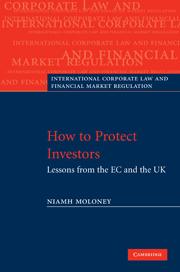Book contents
- Frontmatter
- Contents
- Preface and acknowledgments
- Table of cases
- Table of treaties and legislation
- List of abbreviations
- 1 The retail investor and the EC
- 2 Designing a retail investor protection regime
- 3 Product regulation
- 4 Investment advice and product distribution
- 5 Disclosure
- 6 The trading process
- 7 Education and governance
- 8 Supervision, enforcement and redress
- Index
- References
3 - Product regulation
Published online by Cambridge University Press: 26 February 2010
- Frontmatter
- Contents
- Preface and acknowledgments
- Table of cases
- Table of treaties and legislation
- List of abbreviations
- 1 The retail investor and the EC
- 2 Designing a retail investor protection regime
- 3 Product regulation
- 4 Investment advice and product distribution
- 5 Disclosure
- 6 The trading process
- 7 Education and governance
- 8 Supervision, enforcement and redress
- Index
- References
Summary
Product regulation and the retail markets
The EC and product regulation
Retail investment products (sometimes termed ‘packaged products’) can take myriad forms. They include mutual funds or collective investment schemes (CISs) which pool investor assets (whether held in a corporate or other form and whether represented by a share or other unit), are managed according to investment mandates and redeem investors' investments on demand (or are ‘open-ended’); these structures are the main concern of EC product regulation. Investment trusts or companies which engage in investment business and in which investors hold often listed shares, unit-linked insurance products and a burgeoning array of structured retail investment products are also popular retail market products.
Product design regulation, typically linked to the authorization of the product for public marketing and so associated with segmentation-based regulation, is one of the three arcs of retail market protection along with the regulation of distribution and disclosure. Product regulation in the EC regime is largely a function of the ‘UCITS’ regime which provides a cross-border marketing passport for CISs in the form of UCITS and their management companies. Major reforms in 2002 (the UCITS III reforms) significantly increased the range of UCITS investable assets. The UCITS IV reforms, currently in train, are designed to bring efficiencies to the UCITS market and to reform the UCITS disclosure regime (chapter 5).
- Type
- Chapter
- Information
- How to Protect InvestorsLessons from the EC and the UK, pp. 134 - 191Publisher: Cambridge University PressPrint publication year: 2010

